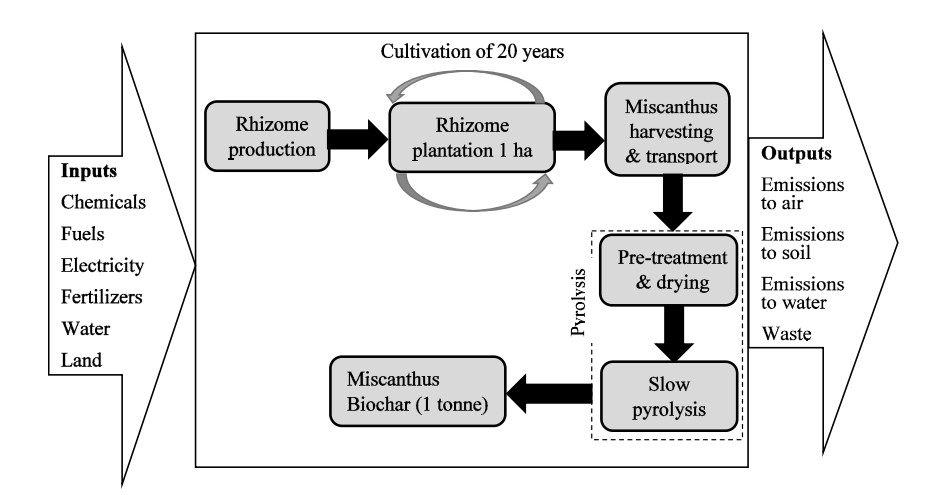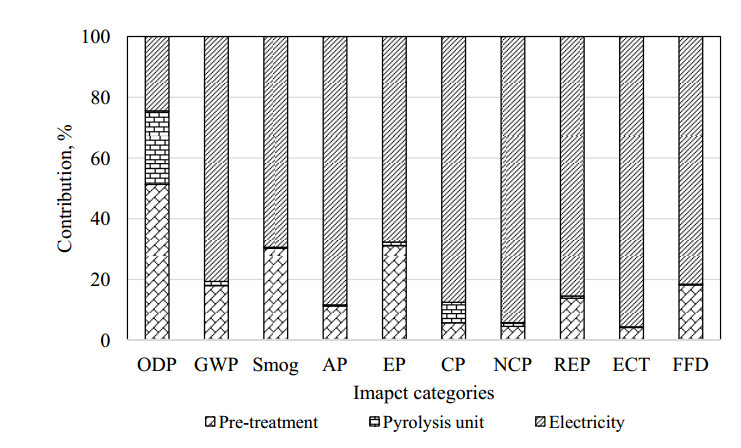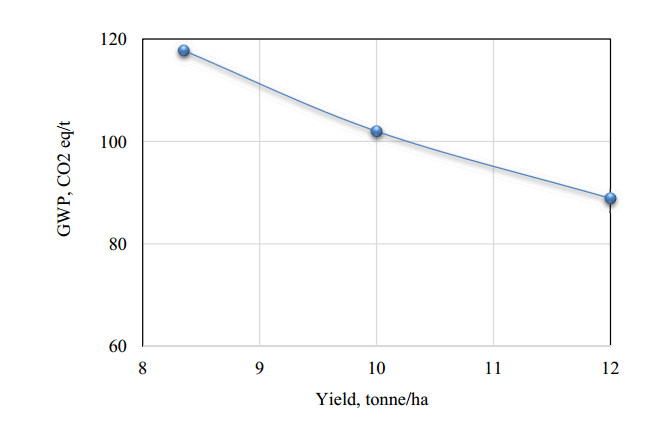Biochar, a hydrophobic biomaterial produced from lignocellulosic biomass is a promising alternative to conventional filler materials. Although a variety of feedstocks have been analyzed for producing biomaterials to a limited extend, a complete LCA study of Miscanthus biochar is scarce. This study evaluates the life cycle of biochar produced from Miscanthus that is grown on the marginal land in Ontario, Canada. Life cycle environmental impacts are determined by using the SimaPro LCA software adopting the TRACI method. The global warming potential (GWP) of the life cycle of biochar is found to be 117.6 kg CO2eq/t. Miscanthus cultivation (93.0 kg CO2eq/t) is the main contributor in the life cycle of Miscanthus biochar followed by pyrolysis (23.3 kg CO2eq/t) and transportation (4.8 kg CO2eq/t). Miscanthus cultivation is also the main contributor to acidification potential and non-carcinogenic potential; however, transportation and pyrolysis are the hotspots in the case of eutrophication, smog and ecotoxicity, and carcinogenic potential, ozone depletion potential and fossil fuel depletion, respectively. The sensitivity analysis reveals that the environmental impacts decrease with an increase of Miscanthus yield. The study provides information on the life cycle environmental impacts of biomaterial which would facilitate in selecting environmentally favorable filler material to replace conventional filler materials to mitigate environmental impacts.
1.
Introduction
It is well-known that the marketing of biomass as a green alternative is important in today's market, whether for combustion purposes, bioproduct fabrication, bioprocessing into transportation fuels or as a filler in composite [1]. Biochar produced from biomass has gained attention because of its renewability and environmental benefits. However, the concern about intensive agricultural inputs and land use change directed the researchers towards energy crops [2]. The environmental benefit of biomaterials is an important element in marketing and its application in the automotive industry in the future [3]. Consequently, there is an opportunity for Ontario biomass producers to move into the emerging biomaterial markets [4]. Miscanthus is a perennial grass that can grow on marginal land almost in all regions of Canada which are not suitable for food crops [5,6]. The benefits of Miscanthus cultivation include good water use efficiency, rapid growth, low nutrient requirement, high yields, low ash content, improve soil fertility, high energy output, and reduce farmers' risks for crop production on the marginal land [7]. In Canada, several authors have evaluated the environmental impacts of heat and power from biomass [8,9]. Although biochar obtained from lignocellulosic biomass recognized as environmentally friendly filler material [10], most of the studies are limited to GWP [8,9,10,11,12]. In order to confirm the environmental benefit of biochar from Miscanthus, a complete life cycle assessment (LCA) is desired [8,13,14].
Biochar is a promising alternative to conventional filler materials [15,16] for producing lighter composites for automotive industry mitigating GHG emissions from this sector [16,17]. The environmental benefits achieved from renewable filler materials mainly because of weight reduction resulting fuel saving opportunity during the use phase of automotive components that incorporates renewable filler materials [15,16]. A wide range of energy crops has been identified as a suitable candidate for biochar production; however, Miscanthus is noted to be the most promising feedstock compared with others [18,19,20,21]. Although a variety of feedstocks have been analyzed either for bioenergy, or biomaterials as a soil supplement to a limited extend (i.e., most of the studies deal with GWP only) [8,9,10,11,12], a complete LCA study of Miscanthus biochar is scarce. For example, life cycle of biochar from switchgrass [21], and forest residues [9] and Miscanthus [18] have been evaluated where various environmental impact categories were not reported, except the GWP. On the other hand Sanscartier et al. [8] have evaluated the GWP of bioenergy from Miscanthus grown on the marginal land in Ontario. Therefore, this study conducts a complete life cycle assessment to evaluate the environmental impacts of Miscanthus cultivation as well as the life cycle of biochar produced from Miscanthus grown on marginal land in Ontario, Canada.
2.
Materials and method
In order to evaluate the life cycle impacts of Miscanthus biochar, the unit process models (Miscanthus cultivation, transportation and pyrolysis) are developed with Simapro software. In addition, the unit process model for electricity is modified with Ontario production data. The US EPA Tool for the Reduction and Assessment of Chemical and Other Environmental Impacts (TRACI, v2.1) method is used to calculate various impact categories. The following ten midpoint impact indicators are analyzed: global warming potential (GWP), acidification potential (AP), ozone depletion potential (ODP), eutrophication (EP), smog formation, respiratory effects (REP), carcinogenic potential (CP), non-carcinogenic potential (NCP), ecotoxicity (ECT), and fossil fuel depletion (FFD).
2.1. Goal and Scope
The goal of this study is to evaluate the environmental impacts of biochar from Miscanthus and identify the hotspots of the life cycle of biochar where the significant improvement can be made. The functional unit of this study is defined as 1 t of biochar. The scope of this study includes Miscanthus cultivation, transportation and pyrolysis (includes pretreatment, i.e., chopping and grinding) over a 20 year period. Miscanthus cultivated on the marginal land in Ontario yields 8.35 t/ha/year [8] is used for a baseline LCA model in this study.
2.1.1. System boundaries
The system boundary of this study includes Miscanthus rhizome production and plantation, transportation, pretreatment, and slow pyrolysis (Figure 1). The data used in this analysis are specific to Canada.
2.2. Inventory
2.2.1. Miscanthus grass cultivation
Miscanthus cultivation data are obtained from peer-reviewed publication and personal communication [8]. It is considered that Miscanthus is cultivated on marginal lands in the province of Ontario [8]. Cultivation of Miscanthus includes establishment phase, fertilization, harvest and termination. The site establishment phase requires 83 l diesel/ha for planting, mowing and spraying with a typical planting density of 8800 rhizomes/ha. The summary of inputs for all phases of the life cycle of Miscanthus for 20 years is reported in the supporting information (Table S1–S3).
2.2.2. Pyrolysis
The pyrolysis unit process model includes pre-treatment, pyrolysis unit and energy (electricity) which produces biochar, bio-oil, and syngas. It is assumed that Miscanthus is transported by 40-tonne trucks. The collection area is assumed to be within a 50 km radius from the pyrolysis plant. The pyrolysis plant is located in Lamington, Ontario, Canada. In the pretreatment stage, Miscanthus feedstock undergoes grinding operation to reduce its particle size to 4 mm. The reduced particle size of the feedstock enables effective mass and heat transfer in the pyrolysis unit (which has a dryer). The initial moisture content in Miscanthus feedstock is assumed to be 20 wt.%, which is then fed into the dryer to reduce its moisture content to 10 wt.%. The pyrolysis plant is assumed to have a daily capacity of 50 t dry matter (DM). The energy consumption in the pyrolysis unit is assumed to be 7510 MJ/t biomass [21]. Slow pyrolysis outputs were estimated based on the mass of feedstock. Biochar, bio-oil, and syngas yield are assumed to be 35%, 35%, and 30%, respectively [22]. Table 1 shows a summary of inventory data for slow pyrolysis.
2.3. Impact assessment
The impact assessment is performed with the TRACI (within the SimaPro Software) method. Midpoints are considered to be linked in the cause-effect chain (environmental mechanism) of an impact category at which characterization indicators can be calculated to indicate the relative importance of emissions in a life cycle [23].
3.
Results and discussion
The global warming potential (GWP) of the life cycle of biochar is found to be 117.63 kg CO2 eq/t. Miscanthus cultivation is the main hotspot in the life cycle of biochar and contributes 93.0 kg CO2 eq/t. In the life cycle of biochar contribution of Miscanthus cultivation phase is followed by pyrolysis and transportation. Miscanthus cultivation is also the main contributor to acidification, smog, respiratory effects, ecotoxicity, and fossil fuel depletion potential; however, pyrolysis and transportation are the hotspots in the case of eutrophication, non-carcinogenic, carcinogenic, and ozone depletion potential, respectively, might be because of chemicals and fertilizer application during Miscanthus cultivation and energy consumption in pyrolysis process (Table 2). Pyrolysis and transportation process are the second and third important environmental contributor accounted for 23.3 kg CO2 eq/t and 4.83 kg CO2 eq/t to the life cycle of biochar, respectively. The transport stage of Miscanthus had a minimal contribution 4.83 kg CO2 eq/t based on the 50 km distance assumed between the pyrolysis plant and the Miscanthus collection site. The observed GWP from Miscanthus cultivation seems to be similar to other studies (104 kg CO2 eq/t) [1]. In contrast, a wide range of impact from energy crops cultivation has also been noted in the literature (Supporting information, Table S4). For example, the impact associated with Miscanthus cultivation is reported to be 40 kg CO2 eq/dt [24] and 158.43 kg CO2 eq/dt [12]. The GWP of switchgrass cultivation phase contributed 145 kg CO2 eq/t [21]. The main reason for the variation in environmental impact from Miscanthus cultivation is due to the variation in Miscanthus yield, land use efficiency, and Miscanthus lifetime used for LCA analysis by a different researcher. The environmental impact of biochar produced by the fast pyrolysis is reported to be 577 kg CO2 eq/t [21]. In contrast, biochar from switchgrass pyrolysis process contributed 36 kg CO2 eq/t [18]. Contribution from this processing stage is attributed to the electricity consumed by the dryer of the pyrolysis unit. Therefore, the natural drying of the Miscanthus feedstock prior to conversion would be environmentally efficient, although this has a minimal environmental impact. For other LCA impact categories, including acidification potential, smog formation, respiratory effects, fossil fuel depletion, and ecotoxicity, a similar trend is observed as GWP for Miscanthus cultivation. Transportation of Miscanthus has the worst environmental impact for ODP and CP. On the other hand, slow pyrolysis has the highest environmental impacts for NCP and EP (Table 2).
3.1. Contribution of different unit processes in Miscanthus cultivation phase
Fertilizer application during Miscanthus cultivation is the main contributor to the cultivation stage. The environmental burden of cultivation stage to GWP, smog, AP, EP, and FFD accounting for 97%, 93%, 95%, 77%, and 94%, respectively. On the other hand, contribution of fertilizer to ODP, CP, and NCP is 14%, 18%, and 10%, respectively. Chemicals (pesticide/ herbicide) application during Miscanthus cultivation shows a severe environmental impact for ODP (60%), ECT (100%). CP (73%), NCN (78%) and EP (17%). In addition to these, rhizome production, field preparation, transportation, and harvesting unit process had a minimal contribution for all categories (Figure 2). The environmental impacts from the cultivation of Miscanthus on marginal land also depend on various factors, such as previous land use, climatic conditions and organic carbon content of the soil [8,25]. In this study, it is considered that yearly soil organic carbon (SOC) increases (0.03 t C/ha/year) due to Miscanthus cultivation on marginal land. It also reported that cultivating Miscanthus would result in SOC sequestration at the rate of 0.16–0.82 t C/ha/year [26]. Even the assumption of a lower sequestration rate would result in substantial GWP credits for Miscanthus cultivation [25]. Generally, during the Miscanthus cultivation stage, application of less fertilizer and chemicals substantially improves the environmental performance of feedstock at the gate of the farm.
3.2. Contribution of different unit processes in the slow pyrolysis process
The electricity (energy consumed in the pyrolysis process which d) is found to be the main hotspot in the pyrolysis process followed by pre-treatment and pyrolysis unit which has the least contribution for all the impact categories except ODP. Pre-treatment has highest contribution to ODP may be because of diesel energy used in the pre-treatment process (chopping & grinding). Contribution of electricity to GWP, Smog, AP, EP, CP, NCP, REP, ECT, and FFD is 81%, 69%, 88%, 68%, 88%, 94%, 85%, 96%, and 82%, respectively (Figure 3). Consequently, replacement of electrical energy with renewable energy in the pyrolysis process is necessary to reduce environmental impacts from the pyrolysis process of the life cycle of biochar.
3.3. Sensitivity analysis
The sensitivity analysis allows evaluating the effect of a change of a certain parameter in the life cycle of the products, processes or services that are studied. It is therefore important to assess to what extent these changes affect the findings. For this study, analyses are performed through changing yield of Miscanthus, the yield of biochar, and allocation of inputs and output in the pyrolysis process based on the energy content of pyrolysis products. A wide range of Miscanthus yield has been reported in the literature, which depends on the type of land, location, etc. [6,7,9,18,27,28]. Consequently, Miscanthus yield is assumed to be varied from 10 to 12 t/ha/year while the reference yield is 8.35 t/ha/year. The effect of the biochar yield has a significant influence on the results. GHG emissions reduce with an increase in biochar yield (Figure 4). For instance, at a Miscanthus yield of 8.35 t/ha/year, the carbon footprint found to be 96.0 kg CO2 eq/t dry matter. However, the GWP of Miscanthus cultivation reaches to 64.0 kg CO2 eq/t and 42.0 kg CO2 eq/t for a Miscanthus yield of 10 t/ha/year and 12 t/ha/year, respectively. Consequently, the environmental impacts from the life cycle of biochar also changed (Supporting information, Table S5). The GWP reached to 102.0 kg CO2 eq/t and 89.3 kg CO2 eq/t of biochar. On the other hand, life cycle environmental impacts decrease with an increase in biochar yield from the pyrolysis process or increased if the biochar yield decreases (Supporting information, Tables S6–S7). The GWP is found to be 133.0 kg CO2 eq/t and 105.0 kg CO2 eq/t for a Miscanthus yield of 30% (i.e. bio-oil 35% and syngas 35%) and 40% (i.e. bio-oil 40% and syngas 20%), respectively. It is important to note that biochar yield depends on the pyrolysis parameters thus energy consumption may also vary to achieve the assumed biochar yield, and may affect the life cycle environmental impacts of biochar. In addition, this study also found that the allocation method also affect the environmental impacts of the life cycle of biochar (Supporting information, Table S8). The GWP varied from 117.63 kg CO2 eq/t to 158.44 kg CO2 eq/t if energy allocation is imposed instead of mass allocation.
4.
Conclusion
This study analyzed Miscanthus cultivation on marginal land and production of biochar by slow pyrolysis using the life cycle assessment method. The GWP of the life cycle of biochar Miscanthus is found to be 117.63 kg CO2/t which depends on the Miscanthus yield and biochar yields from the pyrolysis process. Miscanthus cultivation stage is found to be the main hotspot in the life cycle of biochar. Consequently, any reduction of the use of resources and improvement of Miscanthus yield as well as biochar yield leads to reduce the environmental impacts of the life cycle of biochar. This study provides information on environmental impacts of the life cycle of biochar which would enable the bioindustry in selecting renewable biomaterial for cleaner production.
Acknowledgments
Authors acknowledge the financial support from the Ontario Research Fund–Research Excellence (ORF-RE) round-7 award and the growth fund from the School of Engineering, University of Guelph.
Conflict of interest
Authors declare no conflicts of interest in this paper.










 DownLoad:
DownLoad:






